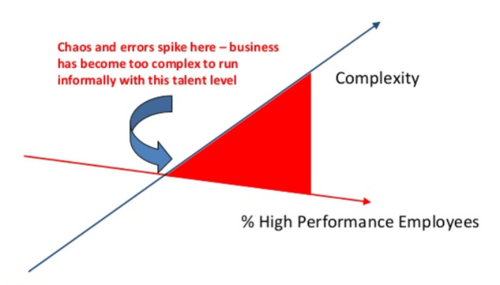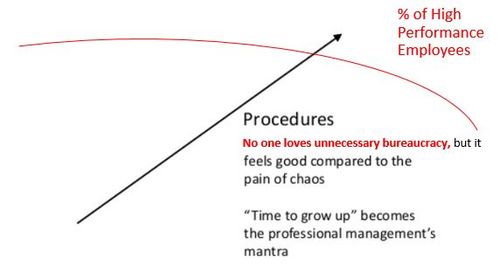Operations and Roles
From Chaos
In business, success often brings growth.
The ambition to expand and be able to have a bigger impact on the industry and the community naturally leads to an expansion in the company’s size. This involves an increase in the number of employees and the layers of the management structure.
Growth leads to complexity and can result in companies becoming disorganized and chaotic.

In an attempt to keep control of the situation, managers often resort to an increase in bureaucracy by implementing more administrative processes in the organization. This often leads to a short-term increase in productivity and stability.

Then, something unexpected happens – a new development comes in the market, a new technology emerges, a competitor makes a surprising move. Then, instead of reacting quickly and adapting, the company is held back by the weight of its unnecessary bureaucracy.
What’s more, the talented staff in the company can feel constrained by the increase in administrative processes and the quality of their work and creativity will suffer.
To Growth
There are three roads a company like this can take in a situation like this.
1. Stay small and avoid adding restrictions, but limit your scope and impact. For Secure Group, this is not a good option, as it would not allow us to achieve our ambitious goals and vision.
2. Avoid rules as you grow and risk becoming too chaotic. This is a big risk for the whole organisation, and often leads to a bad experience for employees and a disorganised workplace. It also hinders the High-Performance Culture we aim for at Secure Group.
3. Use bureaucracy to manage the growing company, but limit creativity, flexibility, and the ability to respond quickly to changes in the market. This approach will not be compatible with Secure Group’s innovative and flexible mindset.
When faced with the challenges of growth, Secure Group responds not with increasing rules and restrictions, but by trusting its High-Performance people. We have faith in our employees and their drive and self-discipline and give them the freedom they need to continue working effectively and remain creative as we expand. This flexibility and flow of ideas is more important to us than plain efficiency in the long term.
Our approach can be summarised in two simple steps:
- Minimise rules as we grow
- Inhibit chaos with even more high performing people
The key to the success of our process management strategy is our people. We aim to minimize the frustrations and extra steps for our processes in order to make room for superior performance.
Our system is dynamic, and big changes can happen overnight. What a person is assigned to today may be different from what they are doing tomorrow. This is why we value our employees’ adaptability and flexibility. It takes a mature person to take responsibility for their tasks and remains concentrated. We realize that may not be easy for everyone, but we strive to attract the highest performers who will be able to adapt quickly and be responsible for their input.
Our processes
But then how do we manage our company without lots of rules and administration getting in the way? Simple – we believe that not all processes are bad. For us, a good process is one that empowers our employees and promotes accountability. We only add those processes that are absolutely necessary and will not get in the way of our staff.
To minimize the necessary processes and rules, we ask ourselves a few questions before we introduce a new process. We determine whether it:
- Represents the current tactic with full knowledge that the tactic may change
- Tries to eliminate individual biases and assumptions
- Allows us to reflect on what is and isn’t working using both qualitative and quantitative data
- Helps us be explicit and transparent, so that everyone knows what we are trying to accomplish.
- Provides our teams with the opportunity to work flexibly, drawing on creative intelligence.
For cross-department, cross-division, and cross-team processes the same rules apply, with the point of attention that when one employee is handing over a part of a process to another employee in the chain, the relevant part has to also promote accountability.
So only when we answer YES to all those points we add the new process to our Responsibility Assignment Matrixes:
- RACI for cross-department processes
- CODE-KS for in-department processes
The RACI matrix
The RACI matrix is a snapshot of all the roles within a cross-department process. It allows us to track accountability and visualize who is responsible for tasks and make sure all assignments are running effectively. This way every member of a project can be informed and easily updated on the progress.
There are a few different roles people can be assigned to in the matrix. They are:
- Responsible (also Recommender): This is the person who needs to do the work to complete a project. There must be at least one responsible person for each task, even if other employees are required to work on it.
- Accountable (or Approver): The Accountable is the person who is responsible for the correct and complete execution of the task. There must be only one person accountable for a specific task, and they are required to delegate the work to those responsible. They must give the final approval of the project before it is submitted.
- Consulted (or Consultant): This is usually an expert whose opinion is sought in relation to a project. There is two-way communication between them and the rest of the people for the task.
- Informed (and Informee): This is someone who is kept up-to-date on the project, often only on its completion. Communication is usually only one-way.
- Support: This is someone who offers support with some specific process or concept on the task.
- Knowledge-Lead: This is someone who's responsible for documenting and delivering training regarding a specific process.
The CODE-KS matrix
The CODE-KS matrix is used for in-department processes and it defines the accountability of each team member in every part of every process. An employee can be accountable for the process:
- Execution: performs the work and completes the tasks.
- Coordination: coordinates the process execution.
- Optimization: analyzes the process and coordinates automation and improvements.
- Design: builds and updates the processes.
- Organization: ponders and anticipates the need for processes based on the strategy and business needs.
- Knowledge-Sharing: creates content and shares knowledge in a structured and well-defined way.
Benefits of using RACI & CODE-KS Matrixes
1. Increases productivity - separating our employees into the right role within a process reduces the amount of confusion in their tasks. This helps them feel less stress and be more relaxed in their roles, as they know exactly what they are responsible for, and what they don’t have to worry about.
2. Makes employee training easier – once we separate employees in the right part of the matrixes, we can ensure they get the right type of training.
3. Decreases frustration with management – when there is an issue with a project and an employee does not know who to turn to for help, they feel frustration. By referring to the matrixes, a person immediately knows who to contact, which saves time.
4. Removes unnecessary meetings – we know who needs an invitation to a meeting based on their role in the project, which saves time for people who are not necessary for the meeting.
5. It aids alignment with organizational strategy – at Secure Group we value accountability. The matrixes take our organizational strategy down to the individual level, which allows our team members to be aware of what they need to be doing to ensure the company’s success. If we need to change our strategy we simply adjust the matrixes and everyone is refocused and moving in the same direction.
6. It enables performance – you will have a much higher chance of being a high performer if you know exactly what you need to be doing.